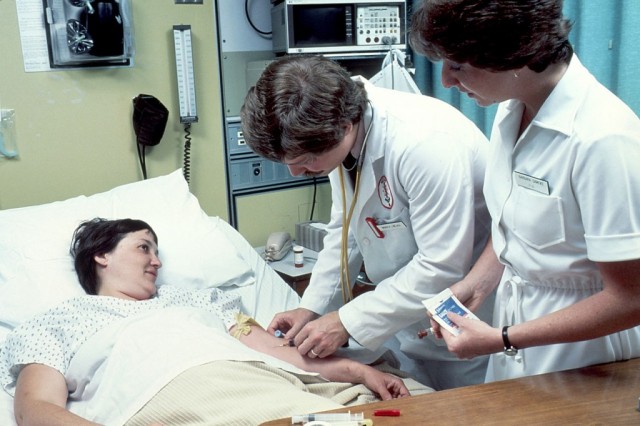June 2005 - A small sore on a toe may not seem like a major medical threat. But for the millions of people who have diabetes and other conditions, it can be the first step on a road that leads to the amputation of a foot -- or even a leg.
Now, a new study from the University of Michigan Cardiovascular Center may help more people save their limbs. Published in the June issue of the Annals of Surgery, it's the first-ever large study of how foot-bone infection, called osteomyelitis, is typically treated and how well the different approaches work.
Because diabetes interferes with the body's ability to heal, even the smallest foot wounds can become infected, spread to the bone, and lead to an amputation. Poor circulation and numb feet, also common in people with diabetes, make the situation worse. More than 80,000 such amputations happen each year in the United States. Experts already recommend that people with diabetes take special care of their feet and have regular foot exams to spot problems early.
The study is the first large account of the prevalence, treatment characteristics and high cost of treating osteomyelitis, which interferes with walking and sends thousands of people to the hospital each year.
On average, it shows, patients stayed in the hospital for about a week at an average cost of $19,000. Almost one in every thousand hospitalizations may be due to foot osteomyelitis, the study suggests.
Continue Reading Below ↓↓↓
"This study grew out of our own observations that many osteomyelitis patients were being treated for months or even years with antibiotics, but not healing, and this can contribute to the loss of their foot or leg," says lead author Peter Henke, M.D., an assistant professor of vascular surgery at the U-M Medical School. "But there's little evidence to guide treatment, so we wanted to look at epidemiology and outcomes. Our results show this is a common, costly issue that needs much further study."
Henke and his colleagues performed the study using data from the Nationwide Inpatient Sample, a database of hospital patient information maintained by the federal Agency on Health Care Research and Quality. They also used data from 237 osteomyelitis patients treated at the University of Michigan. Both sets of data were from patients treated between 1993 and 2000.
In all, the national data showed that 8.5 percent of patients hospitalized for foot osteomyelitis had a leg or foot amputated, and 23 percent had a toe amputated. About 1.6 percent died before leaving the hospital. Patients who were older, African American or had kidney problems were more likely to have an amputation.
Of the U-M osteomyelitis patients, 80 percent had diabetes, and 30 percent had chronic kidney problems. Nearly 40 percent also had blockage in the blood vessels of their legs, a condition called peripheral vascular occlusive disease. Nearly a quarter of the patients died within 31 months of their hospital stay.
"This is a patient population in which a non-healing foot wound becomes an ulcer, exposes the bone, and leads to osteomyelitis," says Henke.
About half of the U-M patients had been on antibiotics before being hospitalized, many of them on intravenous doses of the drugs. On average, patients had been on antibiotics for five months, and 30 percent had had more than one course of antibiotics prescribed to them before being admitted.
However, U-M patients who had been on antibiotics before they entered the hospital were much less likely to heal -- perhaps because the bacteria in their infected wound had grown resistant to antibiotics.
Those who had been on antibiotics for a long time before hospitalization were also less likely to keep their limbs, possibly because the non-healing infection spread too far to allow the foot or leg to be saved. The national data did not include pre-hospital antibiotic use.
But the patients who had blood vessel reconstruction to improve circulation in their legs and feet were several times more likely to have successful wound healing and to keep their foot or leg. Toe amputees were also more likely to keep their limbs.
Patients who had clogged leg blood vessels -- the condition known as peripheral vascular occlusive disease or PVOD -- before their hospitalization were far less likely to keep their legs or feet over time. The patients in the study, Henke notes, were younger and more likely to have diabetes than the typical PVOD patient, but had a higher than usual risk of losing a foot or leg.
Continue Reading Below ↓↓↓
"This study suggests that antibiotics alone are not as effective as surgery plus antibiotics, both for healing wounds and saving limbs," says Henke. "It also suggests that diabetic patients, especially those with PVOD, have a very high chance of developing osteomyelitis -- and that these patients should be considered for aggressive arterial reconstruction or other early intervention. This also really drives home the need for good foot care for all patients with diabetes."
Among the steps recommended for all people with diabetes are to examine their feet daily for any signs of redness, blisters, cuts or sores; to wear well-fitting shoes and protect their feet from injury; and to remove their shoes and socks at each diabetes-related checkup so feet can be examined
The researchers also find that patients whose wounds didn't heal, and those who didn't receive early surgical intervention, were much more likely to use home-health services after leaving the hospital. This kind of care, and outpatient visits, must also be considered when the costs of osteomyelitis are tallied, says Henke. But since surgery can decrease the need for outpatient visits, it may also help reduce costs of caring for a non-hospitalized osteomyelitis patient.
Because the U-M study was performed using retrospective data, the authors say a large prospective study comparing antibiotic use with surgical therapy will be needed to confirm their results before they have an impact on clinical care.
Besides Henke, the study's authors are Susan Blackburn, R.N., MBA; Reid Wainess, B.S., John Cowan, M.D.; Alicia Terando, M.D.; Mary Proctor, M.S.; Thomas Wakefield, M.D.; Gilbert Upchurch, Jr., M.D.; James Stanley, M.D.; and Lazar Greenfield, M.D., all of the Section of Vascular Surgery in the U-M Department of Surgery. Reference: Annals of Surgery, Vol. 241, No 6, June 2005, pp 885-894.
Source: University of Michigan Health System











